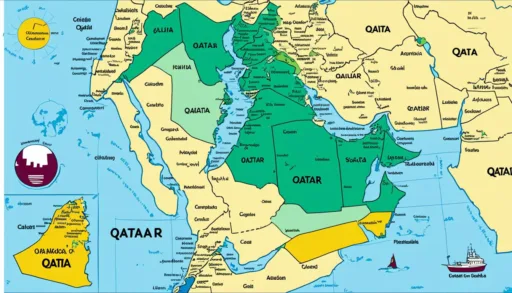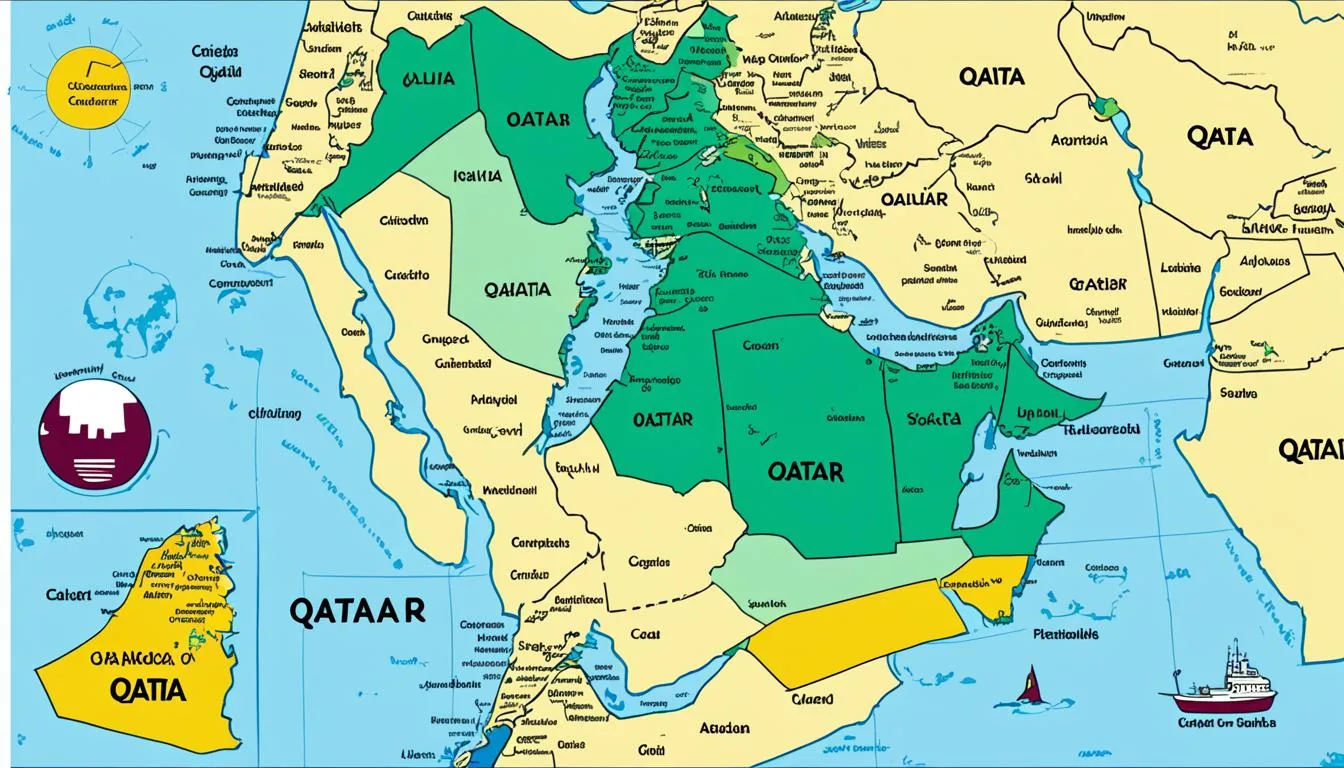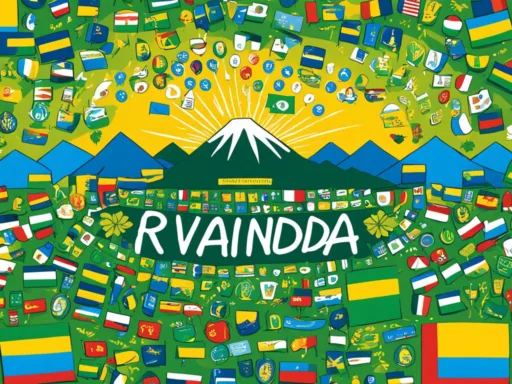Imagine a place where over 650,000 people, nearly a quarter of its population, communicate in a language different from the official one. This isn’t a scene from a science fiction novel; this is Qatar – a nation with a linguistic landscape as diverse as its culture. In this rich tapestry of languages spoken Qatar is not just the sovereign home of Arabic but also a crossroads for a multitude of tongues that have paved their way into daily life. From Qatar language diversity, which spans continents, to the intricate intricacies of the Qatar linguistic landscape, this Gulf nation presents an extraordinary case study of linguistic evolution.
While Arabic stands proudly as the stalwart carrier of tradition and identity, English claims its place as the lingua franca in boardrooms and streets alike. Diverse expatriate communities dot the Qatari language map with speckles of Urdu, Malayalam, and even more, constructing a vibrant social quilt that is as intricate as it is functional. So, buckle up as we dive into the lingual fabric of a country that deftly balances its heritage with the demands of its global presence.
Key Takeaways
- Arabic is the official language of Qatar, with Qatari Arabic being the local dialect.
- Qatar’s language diversity includes languages brought by its significant expatriate population, impacting its linguistic landscape.
- English serves as a key lingua franca in Qatar, especially in business and healthcare sectors.
- Languages from South Asia and Southeast Asia like Urdu and Malayalam are prevalent among the communities they represent.
- The vibrant mixture of dialects and languages in Qatar gives insight into the country’s cultural and demographic makeup.
Unveiling Qatar’s Linguistic Landscape
The diverse social fabric of Qatar is epitomized by its linguistic landscape, where the echoes of Arabic merge with the global cadences of English and other languages brought by the expatriate community. As the world turns its eyes towards this burgeoning economic powerhouse, understanding the language use in Qatar becomes paramount for those looking to connect with its culture and people.
Embedded within the sand-swept edges of Qatar lies a mosaic of dialects and accents, each tile representing a unique story of migration and history. There’s a notable prevalence of South Asian and Southeast Asian languages, which has shifted the Qatar language map to a more intricate tapestry reflecting its melting pot of nationalities. Below is a glimpse into the main languages that contribute to the vibrant linguistic culture of Qatar:
- Arabic (Qatari Gulf dialect)
- English
- Urdu
- Malayalam
- Tagalog
- Hindi
Each language plays a significant role in the daily communication of the people, whether for business, social interaction, or cultural practices. Notably, the expatriate community has brought with them a rich collection of vernaculars, creating a microcosm of languages that have been curated over time, indelibly changing the linguistic identity of the nation.
| Language | Origin Region | Prevalent Use |
|---|---|---|
| Arabic | Middle East | Official and local communication |
| English | Global | Business and expatriate community |
| Urdu | South Asia | Expatriate community from Pakistan |
| Malayalam | South India | Expatriate community from Kerala |
| Tagalog | Philippines | Expatriate community from the Philippines |
| Hindi | India | Expatriate community from India |
As Qatar continues to advance in its infrastructure and economy, the language map perpetually evolves, integrating and adapting to the needs of its cosmopolitan society. The interplay of tongues from myriad corners of the world not only enriches cultural dialogues but also presents a fascinating study of how language use in Qatar is a testament to the country’s globalized ethos.
Languages Spoken in Qatar: Arabic
Delving into the nuances of the official languages of Qatar reveals a fascinating tapestry. Notably, Arabic stands as the bedrock of linguistic heritage and national identity in the region. Amidst the assortment of spoken languages, it is Arabic dialects in Qatar that offer the most profound insights into the country’s rich cultural character.
The Diversity within Arabic Dialects
The intricacies of Arabic speak volumes about Qatar’s history. Encompassed within this linguistic sphere are the Qatar dialects, each with its own idiosyncrasies and charm. The Gulf Arabic, commonly spoken by Qataris, branches into distinct southern and northern dialects. While these dialects are immediately recognizable within Qatar, they also share mutual intelligibility with dialects from several neighboring Middle Eastern countries, thereby knitting a broader cultural connection across regional lines.
Modern Standard Arabic vs. Gulf Arabic
On the continuum of Arabic language variations, the realm of education and formal communication predominantly employs Modern Standard Arabic (MSA). Known as Al Fus-Ha or Al Arabiya, MSA is the scaffold upon which the structure of literary, educational, and official discourse is built in Qatar. Contrastingly, Gulf Arabic, with its intimate colloquial nuances, fosters a sense of local affinity and informality, permeating through daily conversations and personal communication. The dichotomy between MSA and Gulf Arabic perfectly encapsulates the balance Qatar maintains between upholding a global image while cherishing its regional linguistic identity.
The Role of English in Qatar’s Communication
English’s emergence as one of the popular languages in Qatar is a direct result of the country’s unique historical context and its contemporary global interconnectivity. Initially introduced during the time Qatar was a British protectorate, English today permeates various aspects of Qatari life, solidifying its status as an essential tool for cross-cultural dialogue and international business. The influx of a vast expatriate population, hailing from a myriad of linguistic backgrounds, has significantly cemented the position of English as the lingua franca of the nation.
In the bustling streets of Doha or in the boardrooms of towering skyscrapers, English serves as the bridge between the diverse ethnicities that contribute to Qatar’s accelerating development. The government’s endorsing of English as the secondary official language demonstrates a commitment to fostering an inclusive environment that is both open to the global community and sensitive to the multiplicity of languages present within its borders.
Below is an outline of the critical spheres where English plays a dominant role in Qatar’s communication:
- Education: The widespread use of English in Qatar’s educational institutes, particularly in higher education and international schools, equips students with the linguistic skills necessary for global participation.
- Economy: As the host for a variety of international corporations, English is paramount in conducting business, attracting foreign investment, and driving economic growth.
- Social Integration: For the expatriate population, English acts as the communal language, easing social integration and everyday interactions in multiethnic settings.
- Tourism: Catering to tourists from around the globe, English is extensively utilized in the hospitality sector, event management, and related services.
- Healthcare: Medical professionals often communicate in English to serve the needs of both locals and expatriates in Qatar’s health system.
The integration of English into Qatar’s societal fabric has considerably facilitated cultural exchange and mutual understanding among its residents. The synergy of English with the national language, Arabic, showcases Qatar’s evolving landscape as a hub of international communication, further compounded by its role as a major political, sporting, and business player on the global stage.
Indeed, the imprint of English in Qatar is indelibly linked to the broader narrative of the nation’s ambitious vision to cultivate a knowledge-based economy and a diverse, yet harmonious society.
Minority Languages Enriching Qatar’s Culture
The cultural tapestry of Qatar is notably vibrant, owing significantly to the rich language diversity Qatar possesses, a result of the cultural influence languages Qatar has absorbed over time. Beyond the predominant Arabic and English, the presence of minority languages provides a nuanced depth to the country’s cultural identity. Two such languages stand as testament to this ethnic and linguistic infusion: Urdu and Malayalam.
Urdu and its Presence in Qatar
Qatar’s social fabric has been considerably strengthened by the Urdu language, introduced primarily by Pakistani expatriates. Labor migration from Pakistan has resulted in a thriving Urdu-speaking community, with citizens from various regions sharing their linguistic heritage, whilst harmoniously blending with the local Qatari society.
Exploring the Influence of Malayalam
Similarly, the Malayalam language, originating from the Indian state of Kerala, represents another layer of cultural diversity within Qatar. The large number of Keralite guest workers has not only contributed to the economic infrastructure but has also enriched the cultural diversity, manifesting the mutuality between economic migration and linguistic variance.
The confluence of languages such as Urdu and Malayalam in Qatar illuminates how economic migration can weave together a complex and enriched cultural fabric, significantly enhancing the country’s cosmopolitan ethos.
| Language | Origin | Community Size | Cultural Impact |
|---|---|---|---|
| Urdu | Pakistan | Large | High, with Urdu poetry and literature events |
| Malayalam | Kerala, India | Significant | Substantial, with festive celebrations and media in Malayalam |
Qatar’s Linguistic Tapestry: South Asian Languages
In the mosaic of Qatar’s linguistic diversity, the vibrant threads of South Asian languages stand out. They paint a colorful picture of the nation’s cultural richness and the significant role that the South Asian diaspora plays in the social and economic framework of Qatar. Among the various tongues spoken, languages such as Hindi, Tamil, Telugu, Sinhalese, Bengali, and Nepali echo through the streets, workplaces, and homes of South Asian communities in Qatar, adding to the nation’s dynamic linguistic heritage.
The contribution of these languages is not only cultural but also integral to Qatar’s perpetual development. South Asian guest workers are pivotal to various sectors within Qatar, and their languages represent the strong ties between Qatar’s progress and the influx of these international communities. As such, understanding the presence and usage of South Asian languages in Qatar is essential for appreciating the country’s language landscape fully.
A snapshot of the prevalence of South Asian languages amongst Qatar’s population highlights:
- Hindi, as the lingua franca among the Indian community
- Tamil, with a substantial number of speakers from the Tamil Nadu region
- Telugu, representing the Telangana and Andhra Pradesh regions of India
- Sinhalese, from the expatriates of Sri Lanka
- Bengali, adding to the mix from Bangladesh
- Nepali, from the mountainous realms of Nepal
| Language | Region of Origin | Noteworthy Features |
|---|---|---|
| Hindi | India | Widely understood and spoken among South Asian communities |
| Tamil | Tamil Nadu, India | Rich in literature and classical tradition |
| Telugu | Andhra Pradesh and Telangana, India | Distinctive script and strong film industry influence |
| Sinhalese | Sri Lanka | Unique script and literary heritage |
| Bengali | Bangladesh, India | Renowned for poetic and cultural contributions |
| Nepali | Nepal | Integral to the Gurkha identity and history |
Qatar’s recognition of these languages speaks to its embracing of the diverse expertise and cultures that South Asians bring to the table. These languages, while not official, play an undeniably important role in the day-to-day life and cohesion of the communities they represent, contributing to the overarching narrative of Qatar as a hub of cultural and linguistic interconnectivity in the Middle East.
Farsi: A Historical Touch to Qatar’s Language Map
While Qatar is known for its rich language diversity, Farsi stands out as a distinct thread in the country’s historical tapestry. Also referred to as Persian, Farsi has a long-standing presence in Qatar due to the centuries-old ties between the Persian lands and the Arabian Peninsula. Today, Farsi in Qatar remains a testament to the enduring cultural exchanges that have shaped this vibrant Gulf state.
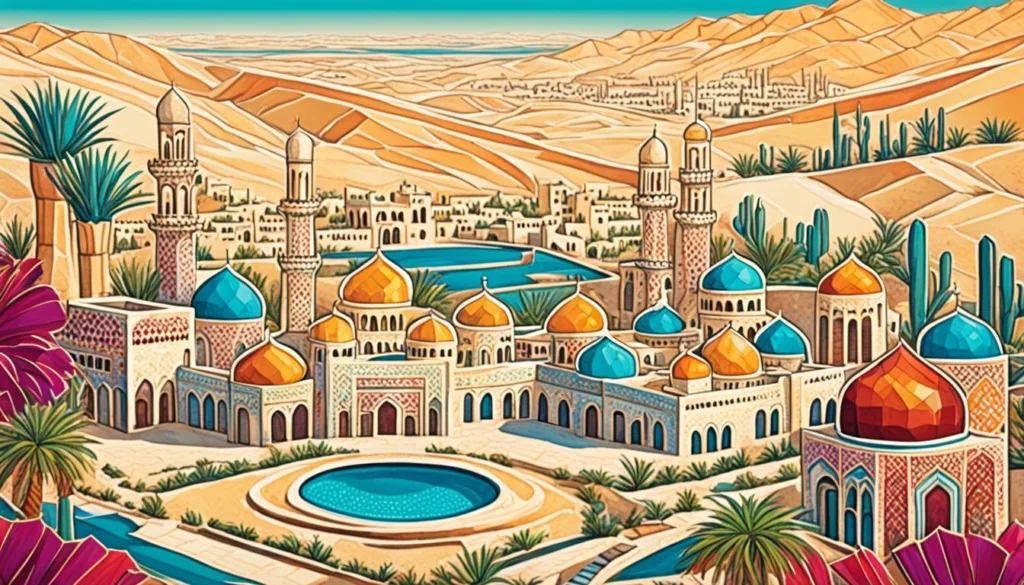
The Iranian Diaspora and Language Use
The Iranian diaspora in Qatar has significantly contributed to the linguistic landscape through the use of Farsi. This has resulted in Farsi securing a place among the historical languages Qatar has cherished throughout the years. With a narrative rooted in centuries of interaction, Farsi speakers in Qatar uphold a legacy that encapsulates both nostalgia and multiculturalism.
| Aspect | Details |
|---|---|
| Historical Significance | Farsi’s introduction to Qatar by early 20th-century settlers from Persia. |
| Current Demographics | Iranian community and Farsi-speaking expatriates residing in Qatar. |
| Cultural Influence | Farsi-speaking Iranians contributing to the artistic, academic, and business sectors in Qatar. |
| Language Preservation | Intergenerational transmission of Farsi among Iranian families and cultural associations. |
The impact of Farsi upon Qatar’s culture and society showcases how historically significant languages can maintain their relevance and contribute to the ongoing narrative of a nation’s identity. Amidst Qatar’s evolutions and transformations, Farsi continues to be a bridge to its past, blending seamlessly with the modern nuances of Qatar’s global community.
The Balochi and Pashto Voices in Qatar
The cultural landscape of Qatar is continually evolving, with the Balochi language Qatar community and the Pashto language use playing pivotal roles. As Qatar thrives, these languages echo the rich traditions and resilience of their speakers, many of whom have traveled from distant lands to weave their narratives into the fabric of this nation.
The Balochi language, although not widely known, is a cornerstone of Baloch cultural identity in Qatar, offering a window into the lives and experiences of the Baloch people from Southern Pakistan. The Southern Balochi dialect is the thread connecting them to their homeland, sustaining a sense of community and belonging even as they contribute to Qatar’s development.
Similarly, Pashto resonates within the Afghan diaspora, each phrase and word spoken is a testament to their enduring spirit. The language has traveled from the valleys of the Hindu Kush Mountains to the expanding metropolis of Doha, bringing with it not just words, but skills and cultural richness.
- Presence of Southern Balochi dialect among the Balochi-speaking community
- Increased Pashto language use by the Afghan workforce in various sectors
- Contribution to Qatar’s economy and cultural diversity by Balochi and Pashto speakers
Through the Balochi language Qatar holds dear and the widespread Pashto language use, we witness the dynamic interplay of cultures far beyond mere linguistic interactions. Together, these languages form an intrinsic part of Qatar’s unique, polyphonic identity.
Tagalog and Filipino Community’s Linguistic Contributions
The impact of the Filipino community in Qatar is palpable not just within the workforce but also in the realm of language. The Tagalog language, an emblem of identity for Filipinos, echoes through the everyday conversations of a nation rich in cultural intersections. It’s in the aroma of adobo at a local eatery, it’s in the laughter of children playing in the parks, and it’s in the earnest exchange between shopkeepers and customers; the Filipino linguistic impact weaves through the fabric of Qatari society.
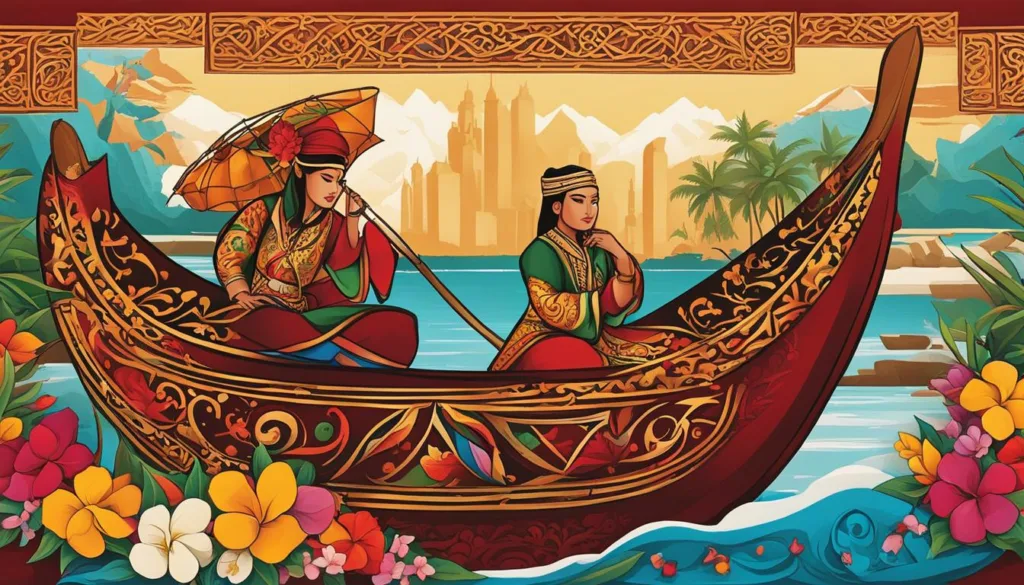
Maintaining Language Ties: The Filipino Scenario in Qatar
For the Filipinos in Qatar, maintaining their linguistic heritage is a cornerstone of community cohesion. Tagalog language Qatar, as a keyword, encapsulates the essence of how language serves as a binding force for the Filipino diaspora. Whether it be in the context of business, education, or social gatherings, Filipinos continue to champion their language amidst Qatar’s vast linguistic tapestry.
| Language | Community Impact | Use in Daily Life |
|---|---|---|
| Tagalog | Gathers Filipinos in social and professional spheres | Commonly used in homes, Filipino-owned businesses, churches, and community events |
| English | Acts as a bridge between Filipinos and other expat communities | Utilized in wider business and educational settings |
| Arabic | Enhances integration with the local Qatari culture | Used for navigation, basic transactions, and formal communication |
The table above encapsulates the trilingual proficiency that many Filipinos in Qatar possess, maneuvering through Tagalog, English, and Arabic to adapt and thrive within this multicultural society.
As we delve deeper into the Filipino linguistic impact on Qatar’s social and economic realms, it becomes clear that language can also act as a vessel of integration, providing expatriates a sense of belonging in their adopted homeland, while also affirming their cultural identity.
The story of the Filipino community in Qatar is not just about language preservation; it is about how language can empower a community to make invaluable contributions to the socioeconomic fabric they are part of, fostering diversity, understanding, and growth.
Unraveling the Trends of Language Use in Qatar
As we delve into the trends in language use Qatar is experiencing, it becomes clear that the nation is witnessing an evolving language pattern. With its economy flourishing and the international workforce expanding, Qatar has become a melting pot of linguistic diversity and innovation. The traditional Arabic tongue coexists with a surge in English fluency, marking a distinct shift in communication and educational dynamics.
The myriad of cultures present in Qatar has given rise to a landscape where multilingualism is not just prevalent but celebrated. English, in particular, has emerged as a linchpin in this evolution, propelled forward by the need to foster clear and effective channels of communication within its diverse global workforce.
The modern Qatari society is tilting towards a practice where the integration of multiple languages in everyday communication is increasingly standard. This shift is partly fueled by the strategic emphasis on English education and its perceived value in the global marketplace.
Below is an insightful display of the variety of languages that make up the country’s evolving language tapestry:
| Language | Origin | Usage Within Qatar |
|---|---|---|
| Arabic (Qatari) | Local | Daily, Official |
| English | International | Business, Education, Expatriate communities |
| Urdu | Pakistan | Expatriate communities, Cultural Events |
| Malayalam | India (Kerala) | Expatriate communities, Cultural Events |
| Tagalog | Philippines | Expatriate communities, Social and Domestic spheres |
This table not only reflects the linguistic variety within Qatar but also underlines the essential role each language plays in weaving the societal fabric of the country. As the demand for English proficiency rises, so too does the opportunity for cross-cultural exchanges, fostering an environment where the evolving language patterns contribute to both personal and economic growth.
- Understanding the expanding linguistic norms in Qatar is key to grasping its developmental trajectory.
- Recognition of these trends helps in appreciating the complex yet cohesive identity that Qatar has carved out on the world stage.
In essence, the expanding horizons of language adoption in Qatar symbolize a broader, more inclusive approach to lingual expression and international connectivity. The country’s multilingual fabric is a testament to its adaptability and openness to global influences while retaining its own vernacular heritage.
The Vibrant Mixture of Dialects and Languages in Qatar
In the heart of the Middle East lies a cultural and linguistic marvel that is Qatar. Driven by its ambitious vision for the future, this small nation boasts an exceptional mix of dialects and languages, rendering it an exemplar of multicultural language dynamics. Qatar’s position as an economic powerhouse has cultivated a fertile ground for the growth of Qatar’s vibrant language mix, thus enabling a myriad of cultures to communicate and thrive within its borders.
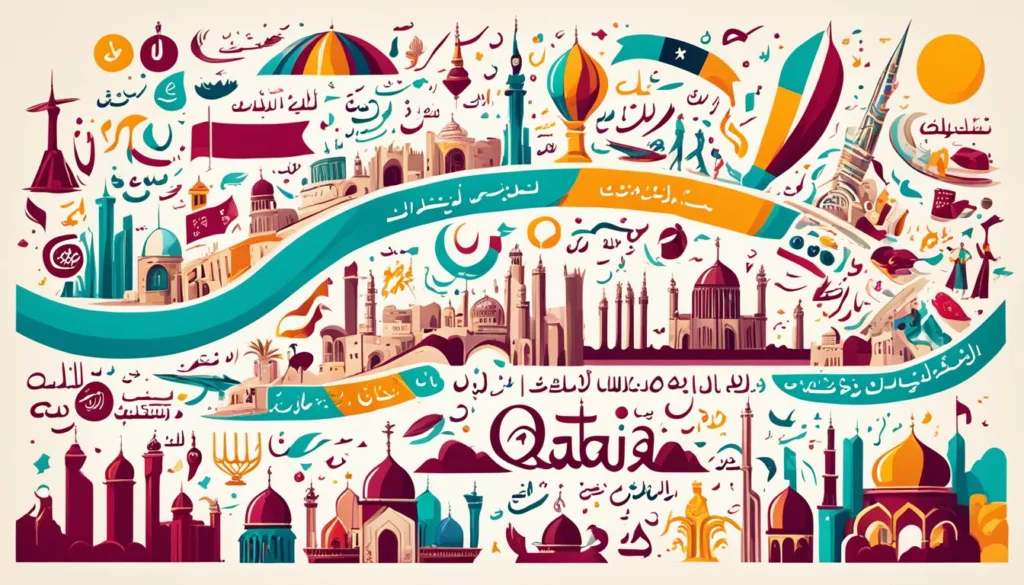
Understanding Qatar’s Multicultural Language Dynamics
Qatar’s captivating language variety is a direct consequence of its diverse population. Key to understanding these dynamics is recognizing the country’s openness to global influences. As home to a vast number of expatriates, each community brings a fragment of their linguistic heritage, contributing to the intricate tapestry of spoken word. From the bustling souqs to the corporate boardrooms, variety in language befits the evolving identity of Qatar.
Qatar’s Language Diversity: A Bridge or a Barrier?
While the richness of Qatar’s vibrant language mix significantly defines its societal structure, it also raises questions about the sustainability of such diversity. The amalgamation of languages can be a bridge for intercultural enlightenment, fostering mutual respect and understanding. Conversely, it may present a barrier in conversations and policies aimed at maintaining cohesive national identity. This duality symbolizes the intricate balance that Qatar navigates, reconciling its preservation of tradition with its embrace of globalization.
- Arabic dialects foster a sense of unity among nationals.
- English serves as a lingua franca, supporting international exchange.
- Expatriate languages enrich cultural practices, offering a slice of global heritage.
- Linguistic growth shapes Qatar’s narrative as a cosmopolitan hub.
The influences of multicultural language dynamics in Qatar resonate beyond everyday conversation, weaving into the social, political, and economic pillars that support the nation’s grand vision for the future.
Education’s Impacts on Qatar’s Language Diversity
The constant evolution of Qatar’s linguistic landscape is heavily influenced by the country’s educational policies. The prevalence of English in educational institutions is not by coincidence but by design, as English-medium schools in Qatar cater to both the expatriate community and nationals seeking international competencies. This educational influence facilitates a bilingual or even multilingual society, contributing greatly to the language diversity within Qatar.
Qatar’s strategic educational initiatives underscore the country’s commitment to fostering a competitive, globalized citizenry, while also preserving linguistic heritage.
Here’s a closer look at how the educational system impacts language dispersion:
- Language Instruction: Multitude of schools in Qatar encourage bilingual education, primarily in Arabic and English, shaping students to operate effectively in a global context.
- Cultural Appreciation: Institutions instill an appreciation for multiple languages within their curricula, thereby promoting cultural understanding and diversity.
- Academic Opportunities: With many universities offering programs in English, students are often predisposed to operate and communicate in an English-dominant academic environment.
The educational influence on languages in Qatar is an excellent example of how a nation’s language policy and educational practices can support a thriving, adaptable, and diverse linguistic landscape. While English gains ground, the ongoing educational investment in language programs ensures that the mosaic of native languages retains its color and vitality in Qatari society.
Conclusion
As we reflect upon the Qatar language diversity conclusion, it’s clear that the nation’s linguistic canvas is as intricate and colorful as its history and people. Arabic, with its local nuances, and English, a cornerstone in business and daily communication, stand as testaments to resourcefulness and adaptability within this multicultural landscape. The influx of an expatriate workforce from all corners of the globe has woven additional threads into this cultural tapestry, introducing languages that range from Urdu to Malayalam, and beyond.
Education plays a pivotal role in Qatar’s linguistic evolution, fostering a bilingual, if not multilingual, society where language preservation goes hand in hand with global engagement. The embrace of multiple languages in academic settings does more than just teach students to converse; it prepares them for a world that is increasingly interconnected and culturally diverse. As a linguistic crossroad in the Middle East, Qatar showcases the beautiful complexity of a nation walking the line between tradition and modernity.
The confluence of such varied linguistic strains highlights not only Qatar’s commitment to cultural diversity but also its strategic navigation through the challenges and opportunities that come with it. The nation’s continuous dialogue between its historical roots and a forward-looking approach to global communication strengthens its identity as a vibrant, inclusive hub thriving in the heart of the Gulf. Indeed, the symphony of languages spoken in Qatar is a melody that resonates with the pulse of progress and unity.
